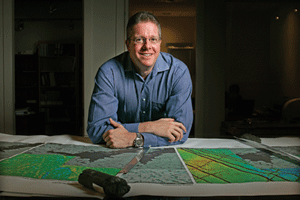A better way to heal

Diana Hall ’97 is living her dream. Using her chemical and software engineering background plus her passion for user-friendly medical treatment, Hall is making huge innovations in custom devices with 3D-printed casts and splints, improving efficiency for doctors and, more importantly, quality of life for patients.
Hall’s company ActivArmor takes a 30-second scan of a patient’s injury, then prints a custom-fit, waterproof, breathable orthosis. They can be used while bathing or swimming and are popular with doctors and patients alike due to the ease with which they can be produced and cared for, with minimal impact on daily activities.
Hall first got the idea for ActivArmor while volunteering with children in a low-income area of her hometown, Pueblo, Colo. She noticed children with injuries would often go for days without bathing or washing their hands to avoid getting their plaster casts wet. One child even ended up with permanent scarring due to a wet cast. Inspired by what she saw, Hall 3D-printed a custom splint for the boy and told him to ask his doctor if he could use it. She received a call from the doctor the next day, she said, asking if she could make more.
“It was then I realized I could make a viable business out of it, not just help people but have it be something there was demand for in the market and that could actually be revenue positive,” Hall said. “After three years of field tests and commercial sales, that’s where we’re at right now.”
Hall’s technology has extended to more high profile patients—professional athletes. NFL players, an Ironman champion and an Olympic swimmer have used ActivArmor’s gear, and a professional hockey player was even able to stay in shape on the ice while his arm healed, allowing him to return to the game sooner than he may have otherwise.
Though it’s not only athletes who benefit from ActivArmor. The product is covered by insurance and thus widely available, and Hall thinks it will make a particularly big impact in pediatrics, geriatrics and other populations where the proper care for a traditional cast can be challenging.
But for Hall, the most important aspect of utilizing this technology is patient quality of life. Having witnessed the challenges her brother faced growing up with cystic fibrosis, Hall said she understood how hard it is for patients to adapt to things that aren’t specifically made for them.
Now, Hall said, she finally understands how her varied background—including a degree in chemical engineering and a career in chemical and software engineering—comes together. “I didn’t understand how all those experiences were leading up to what I was meant to do,” she said. “And now I get up every morning, and I think, ‘I would do this for free.’”
Hall said that it was her experience at Mines that prepared her for this new step in her career. “The people who have degrees from Mines not only have sheer grit, but they have the tools they need to succeed,” she explained. “A degree from Mines is so valuable because you can build anything off of that.”



